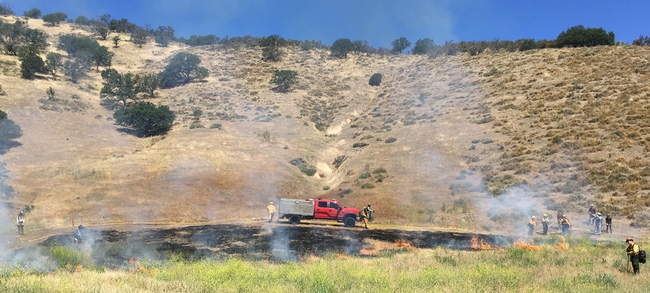With a $379,785 grant from CAL FIRE, UC Cooperative Extension and the Resource Conservation District of Monterey County are spearheading a community effort to create a prescribed burn association along California's Central Coast region.
The grant is one of 55 awarded by CAL FIRE to reduce the risk of devastating wildfires that take lives and destroy homes and valued wildland environments across California.
“These 55 local projects will play a critical role in augmenting our fire prevention efforts,” said CAL FIRE director Chief Thom Porter.
Prescribed burn associations (PBAs) are made up of ranchers, volunteer firefighters, non-profit organization and other community members. They pool their resources and energy to plan and conduct prescribed burns on private land. The first California PBA was established in 2018.
“Improving forage and reducing fire risk are key goals of our prescribed burns,” said Devii Rao, UC Cooperative Extension natural resources advisor and project manager. “We will also plan fires to control non-native invasive weeds and restore and enhance wildlife habitat.”
Funds for the CAL FIRE grant program are part of the California Climate Investment, a statewide program that uses cap-and-trade dollars to reduce greenhouse gas emissions, strengthen the economy, improve public health and conserve the environment. While prescribed burns emit smoke and carbon dioxide, the amount is much lower than high-intensity wildfires.
Rao said UCCE will be holding workshops and meetings to teach potential association members and the general public about fire ecology, fire permitting, prescribed burn planning and liability associated with burning.
“People are really seeing the value of prescribed fire and they are seeing that it's better to have several smaller burns throughout the year as opposed to these giant, catastrophic wildfires that cause so much damage,” Rao said. “If we can have many smaller burns, we can achieve resource conservation goals, we can achieve forage improvement goals and we can improve fire safety all at the same time.”
Grazing cattle for fire safety
Rao is also leading a study, funded by the California Cattle Council, to better understand the influence of livestock grazing on fire safety of California wildlands. This project is in collaboration with UCCE rangeland specialist Luke Macaulay, UCCE livestock and natural resources advisor Sheila Barry, rangeland consultant Felix Ratcliff and recent UC Berkeley graduate Rowan Peterson.
The researchers used brand inspection data, USDA Ag Census data and county crop reports to estimate the number of rangeland cattle in each county across the state. They estimated how much forage – or from the fire safety perspective, how much fuel – the cattle are consuming.
“Thanks to Felix's great work analyzing these multiple complex datasets, our preliminary results show that cattle consumed approximately 12.4 billion pounds of forage across California in 2017,” Rao said.
Tulare County had the greatest amount of wildfire fuel consumed (1.3 billion pounds), and Orange County had the least (896,000 pounds). Forage removed per grazed rangeland acre ranged from a low of 13 pounds per acre in Alpine County to 2,157 pounds per acre in Tulare County.
Counties in the San Francisco Bay Area, the Sacramento and San Joaquin Valleys, the Sierra Nevada Foothills, and the northernmost counties in the state had somewhat higher removal of wildfire fuel per grazed acre compared with other counties in the state.cedx
“Our analysis is currently ongoing. However, this preliminary analysis shows that many counties have adequate rangeland grazing to significantly reduce wildfire risk, at least in certain strategic areas,” Rao said.
In many counties, grazed rangelands are only a fraction of total grazeable rangeland.
“These counties highlight opportunities for grazing to help fight wildfire risk,” Rao said.
